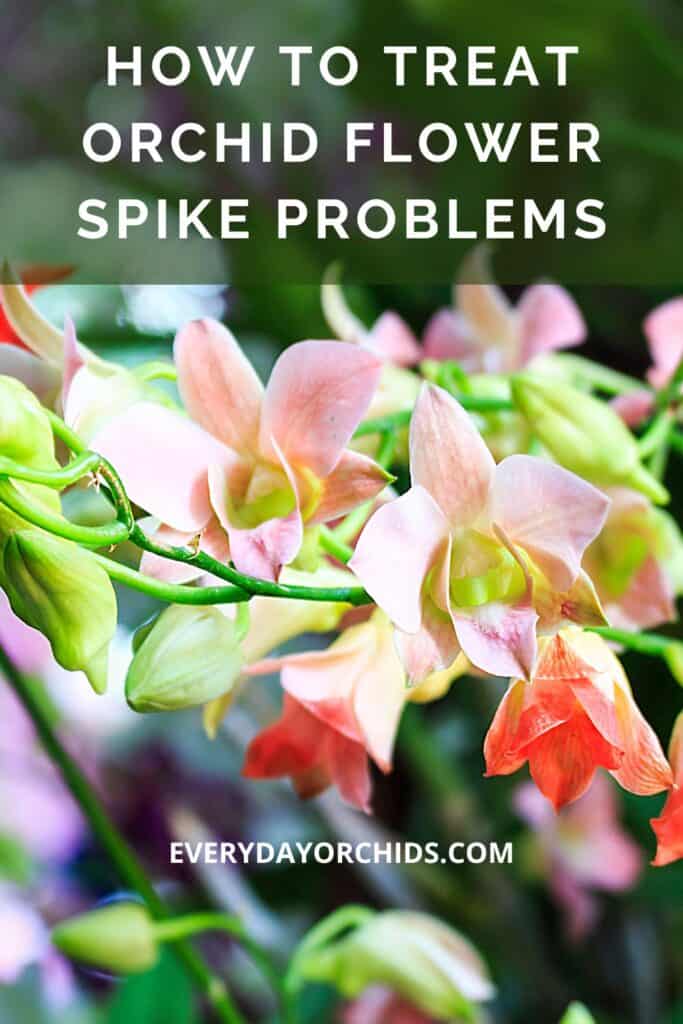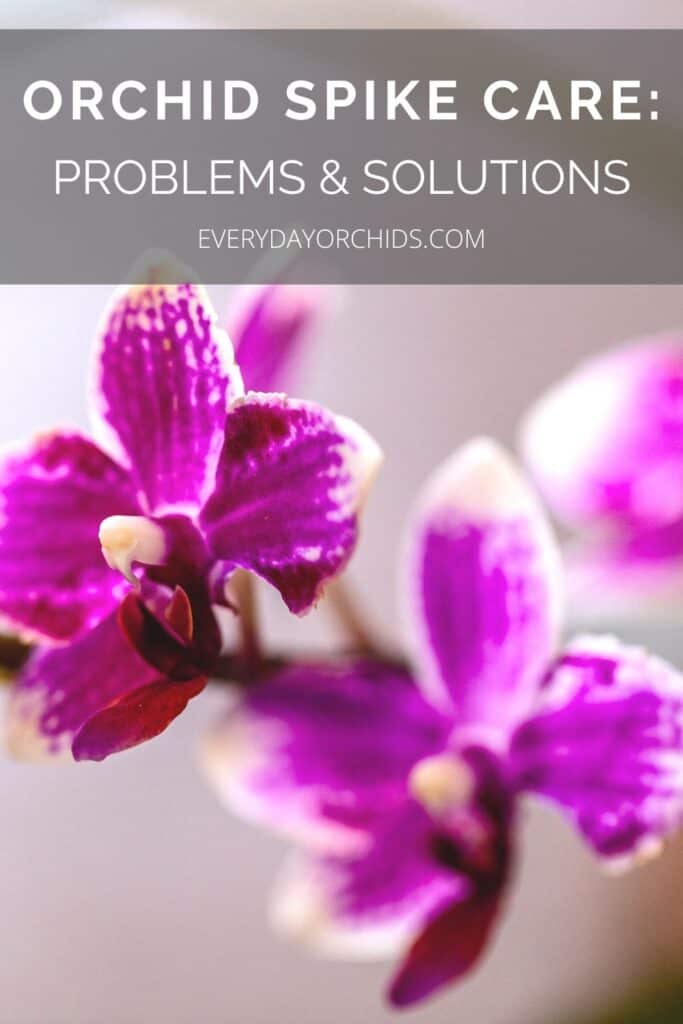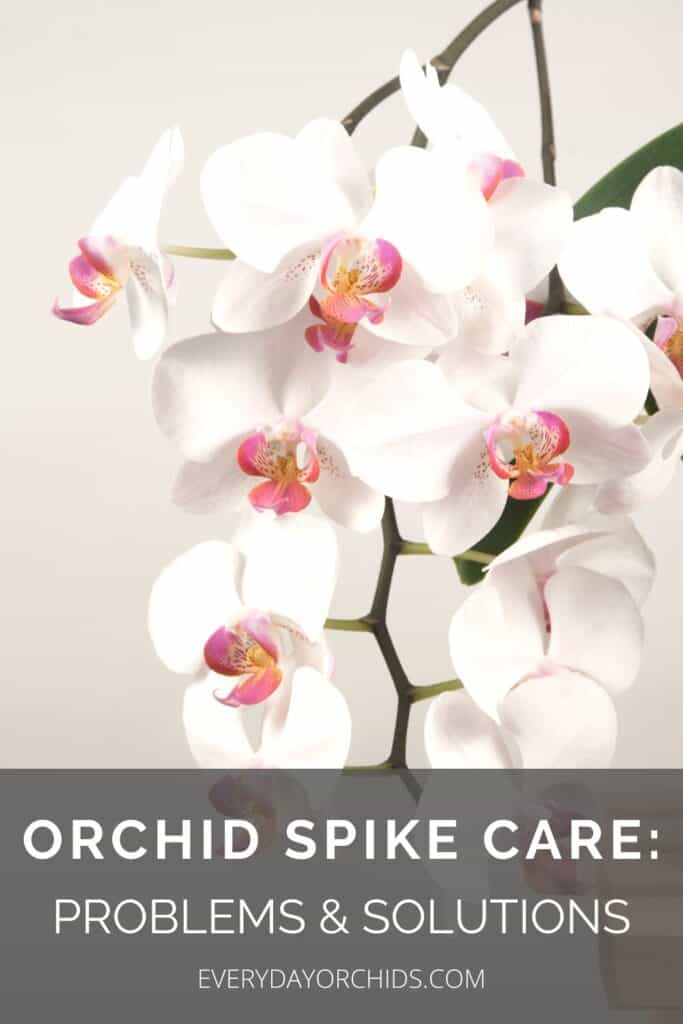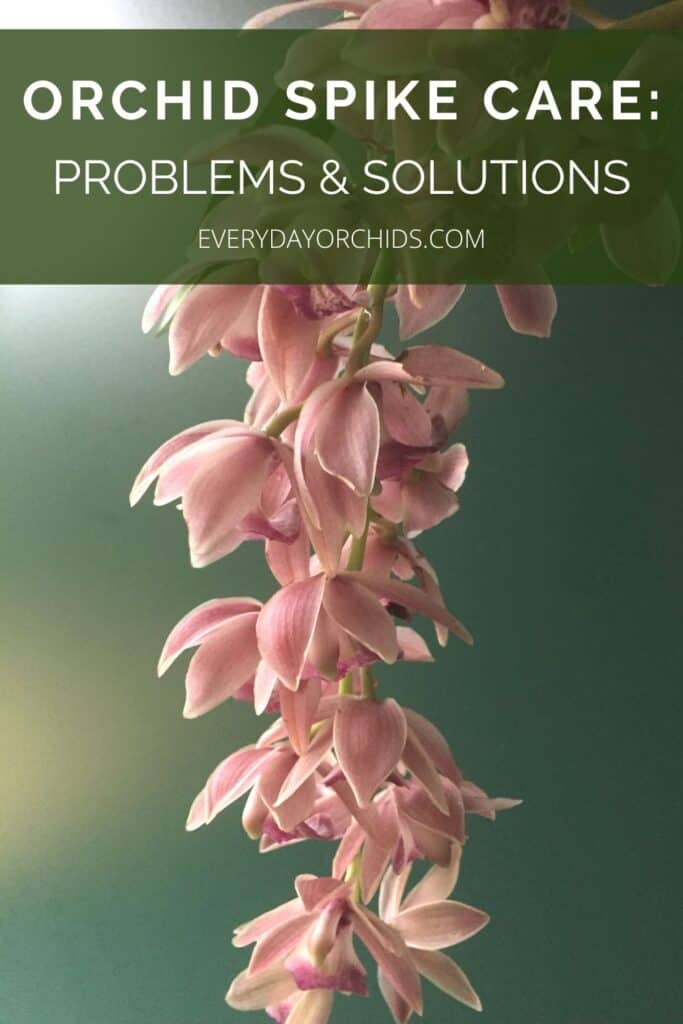When caring for our orchids, we don’t think much about the orchid flower spike care—until we spot a problem. Then we want to know how to treat it.
Typically, we tend to pay the most attention to the orchid roots, leaves, and flowers. It makes sense—we water the roots, watch the leaves for problems, and wait for the flowers to bloom.
The question is, what do we do if our orchid’s flower spike stops growing, grows sideways, or breaks off?
Orchid flower spike problems are not a sign that the plant is unhealthy. Instead, they can occur due to accidents or can signal that something is happening with the blooms. If your flower spike stops growing, breaks off, grows sideways, or changes color, it does not mean your orchid will die.
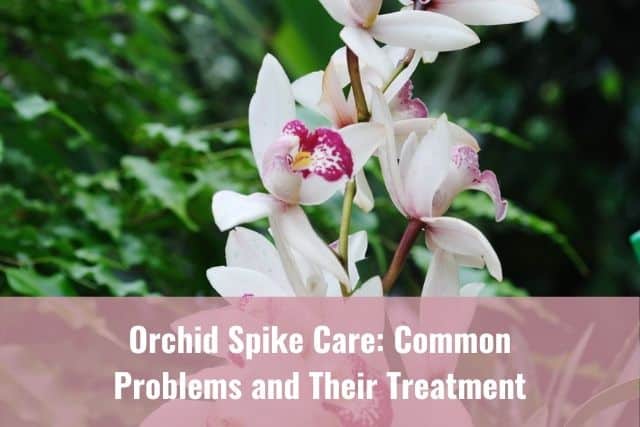
In this article, I will go over some of the most common orchid flower spike problems and how you can address them. You’ll learn what to do if the flower spike stops growing, breaks off, or grows sideways. I’ll also explain what it means when the orchid flower spike turns different colors, as well as what to do about a terminal flower spike. Keep reading to learn more.
Please note that these links are affiliate links and as an Amazon Associate, I earn from qualifying purchases. Purchases made through affiliate links in this post may generate commissions at no additional cost to you. Use this link for a free or discounted Amazon Prime trial. Thank you for your support!
Table of Contents
Orchid Flower Spike Stopped Growing
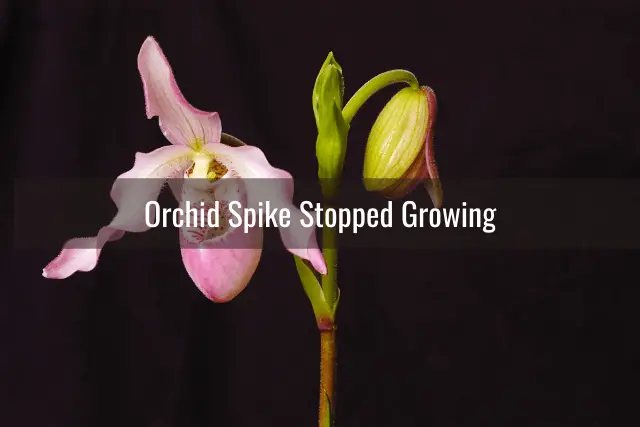
When the flower spike stops growing, it can be both alarming and puzzling, especially if you have been taking good care of your orchid. If the roots are still growing and the orchid’s crown looks healthy, the flower spike should keep growing, right? You may think this, especially if you have not made any changes in how you care for your plant.
In that case, the orchid flower spike could have stopped growing because something in the environment has changed. This can be seasonal change, a change in location, or the orchid was turned so that the flowers face into the room instead of towards the window. Any one of these factors could cause the orchid to conserve its energy instead of create new flowers.
Addressing this problem will require patience. Sometimes you will be able to get the orchid’s flower spike to start growing again, but this will not always be the case. Here are some tips on how to care for an orchid once the flower spike has stopped growing:
- Continue taking care of your orchid as you normally would. This means optimal light, water, humidity and regular fertilization.
- If your orchid is in a location with insufficient lighting, move it to a location where it will receive bright, indirect light.
- You can also purchase grow lights and supplement the lighting with artificial lighting for your orchid if needed.
- Consider repotting the orchid, especially if you see new orchid roots or leaves emerge. This is a sign that the orchid has stopped blooming and is in it’s growth phase. The plant is already devoting energy to root growth and will recover more quickly from repotting.
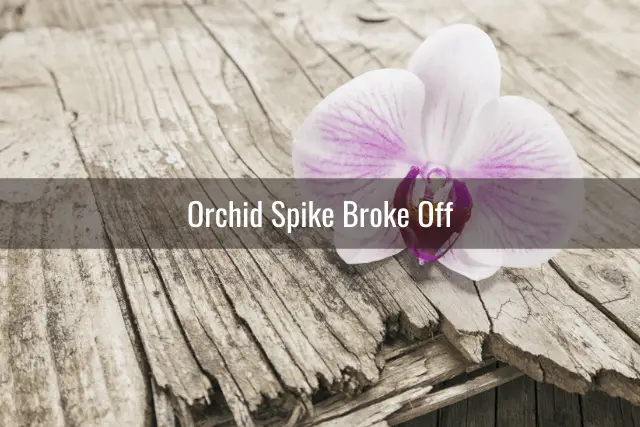
Orchid Flower Spike Broke Off
An orchid flower spike breaking off is disappointing, to say the least. You were looking forward to the buds opening, revealing your orchid’s gorgeous flowers. Now you are left wondering if your orchid is damaged and whether you can still save the flower spike and blooms.
Orchid flower spikes can break off for a number of reasons, including the pot getting knocked over by children or pets or the plant being too top-heavy.
You can avoid these scenarios by placing your orchids in places where children and pets cannot reach. You can also double-pot your orchids to provide a more stable base of support. Staking your orchid’s flower spikes as they grow is also key.
However, if your orchid’s flower spike has broken off, don’t stress. There are a few things that you can do to try to salvage your orchid’s flower spike and blooms. The solutions to this situation depend on whether the flower spike is completely broken off or if it is still attached.
The Flower Spike Is Completely Broken Off
An orchid flower spike that is completely broken off cannot be reattached to the plant successfully, nor would you want to.
If this happens, you will be left with two pieces of the orchid flower spike: the top part with either open blooms or unopened flower buds, and the bottom part, which is still attached to the rest of the orchid.
Here are some suggestions on what to do with the broken flower spike.
Dealing With The Bottom Portion Of A Broken Orchid Flower Spike
Let’s address the bottom part of the flower spike first. I would suggest watching and waiting for a few weeks. Don’t attempt to prune off the rest of the broken flower spike just yet. Sometimes a new, secondary flower spike will emerge from a node further down along the original flower spike. My orchids have done this on several occasions.
However, if you don’t feel like playing the waiting game, you can also take steps to force a secondary flower spike to emerge. You can do this by pruning your orchid in such a way as to encourage reblooming on the remaining section of the flower spike.
Other times, the remaining portion of the flower spike will simply turn yellow, then brown, as it starts to die off. In these cases, a secondary flower spike will not emerge from a lower node.
Overtime, the entire flower spike will turn brown and dry out. If this happens, you will need to use some gardening shears to prune off the dead flower spike.
On a side note, depending on the length of the broken orchid spike, and whether or not it has enough nodes, you might even be able to grow a new orchid from this flower spike. This is called propagating orchids. You can learn more in this guide to orchid propagation.
Dealing With The Top Portion Of A Broken Orchid Flower Spike
As for the top section of the broken off orchid flower spike, you can try to salvage it and keep it alive a little longer. This process is going to be similar to how you would care for cut orchid blooms.
Slant-cut the broken orchid stem and put it into a tall vase filled with an inch or two of water. Change the water once every two or three days.
You might be lucky and have several buds bloom, especially if they were within a week or so of opening. Any opened orchid flowers will continue to bloom for several weeks, especially if these are Phalaenopsis orchids.
However, this is not always guaranteed. If the orchid buds were tightly closed when the flower spike broke off the plant, there is a high chance that you won’t see them bloom. This will turn into a waiting game to see if any part of the spike is worth rescuing.
While having an orchid flower spike break off is distressing, remember that the flower spike is not essential for the survival of the plant. Continue to care for your orchid as you normally would. Chances are, it will rebloom the following year.
What To Do If The Orchid Flower Spike Is Partially Attached
If the orchid’s flower spike is still partially attached, you might have success using a splint. The thicker and older the spike, the less likely a splint will work.
Here are several methods for creating splints:
- Tape or Band-Aid. This may sound strange, but a band-aid or tape is a good option. Wound tightly around the spike, it can do a good job of holding the two parts together. However, as the flower buds open, the end of the flower spike will become heavier. Be aware that these splinting measures might not be strong enough to hold up the extra weight.
- Straws. A sturdy straw cut down the middle works as a cast for the spike. However, a straw does not apply much pressure, so the pieces might not reattach. You can use this in conjunction with a piece of tape or band-aid.
- Splint. Creating a splint is the preferred method. It provides the strength of the band-aid method and the airflow of the straw method.
These tips might prevent the orchid flower spike from breaking again:
- Use heavy orchid pots to prevent a top-heavy orchid from tipping over. Alternatively, you can do the double-potting method outlined in my guide to orchid pots.
- If you must move an orchid, do so carefully to keep the plant from brushing against something.
- I recommend staking your orchid’s flower spikes to give them extra support and reduce the chances they will break.
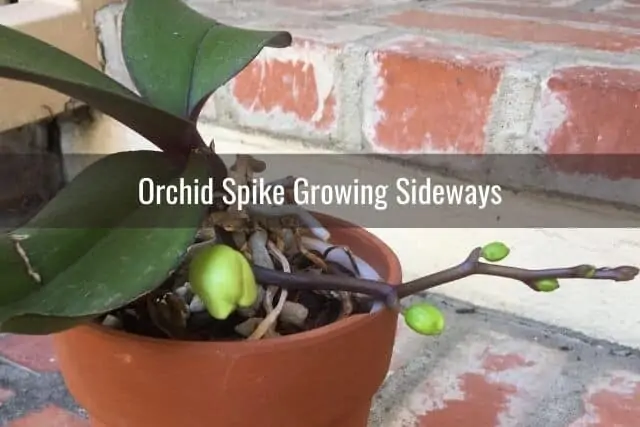
Orchid Spike Growing Sideways
The orchids we see in stores or nurseries with their spikes growing straight up do so because they were raised in a greenhouse where their source of light was above them. This fools people into believing that orchids always grow that way.
In truth, orchids, like most other plants, grow towards the light. If the light is coming from the side, the flower spike may start to grow sideways.
There are a few ways to address an orchid spike growing sideways.
Change The Lighting
The first thing you can do is to make some lighting adjustments. Make sure the main source of light is coming from overhead, not from the side. This will help the flower spike grow upwards, towards the light, instead of straight out the side of the orchid.
However, you’ll need to make this lighting adjustment early on. Once the flower spike starts to develop, try not to move or reposition your orchid too much. Moving it after the flower spike has formed can result in a twisted flower spike. This is because the orchid is constantly trying to adapt and turn towards the light. I know this from personal experience!
If you don’t have a good source of natural lighting in the home, you may need to use artificial lighting. This is not necessarily a bad thing, as many orchid growers like to supplement with grow lights.
Train And Stake The Orchid Flower Spike
Another way to address a sideways growing orchid spike is to train, also known as grooming, the stem to grow straight. This is done by staking the spike. Use these tips as you stake your orchid:
- When you insert the orchid support stake, do it carefully and avoid damaging the roots.
- Use plastic orchid clips or twist ties but avoid wire. Wire twisted tightly around a growing flower spike can cause damage.
- Avoid placing orchid clips on nodes. Instead space the clips evenly apart along the flower spike between nodes.
- Place the final clip an inch or so below the top node. This way, the orchid flower spike can curve naturally down, creating an arch of blooms.
You can read more about how to stake orchids here. If you want to take it a step further, you can also do fun shapes with your orchid flower spikes. Read this guide on how to create shaped and spiraled orchid flower spikes for more information.
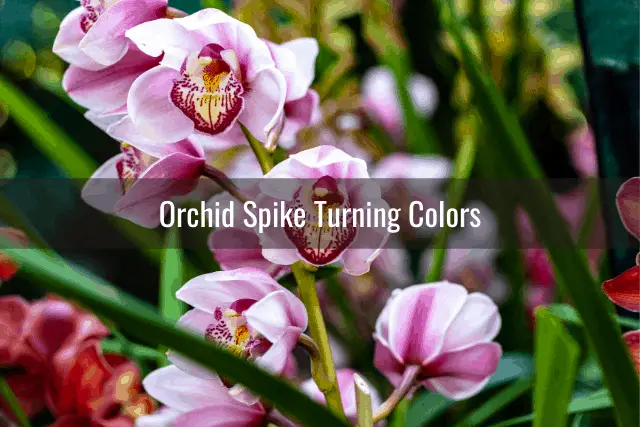
Orchid Spike Turning Colors
We tend to watch orchids more carefully than other houseplants so that any change can feel worrisome. For example, what does it mean if an orchid flower spike changes color? Let’s examine a few scenarios:
- Red or yellow orchid flower spike. In Phalaenopsis orchids, a red flower spike signifies that the orchid is receiving too much light, akin to humans getting a sunburn. Sometimes, an orchid can have a red flower spike due to genetics. This is normal.
- If your orchid’s red flower spike is due to too much light, you will need to relocate your orchid or use a thin curtain to cover the window.
- If you do move your orchid, the move does not have to be far. Moving the plant out of direct sunlight should be enough to fix this.
- Yellow or brown orchid flower spike. An orchid spike will turn yellow or brown to signal that it is dying. Essentially, the orchid stem is finished transporting nutrients to the flower and the flower spike’s job is done.
- If the spike is entirely brown and dried up, prune it off at the base.
- Brown or black orchid flower spike. Brown or black spikes could be a sign of disease or infection. The most likely cause is overwatering. The spike will need to be cut off using a pair of gardening shears.
- Be sure you sterilize your gardening tools before and after use to prevent the spread of disease.
- Check the roots as well. It might be time to repot your orchid.
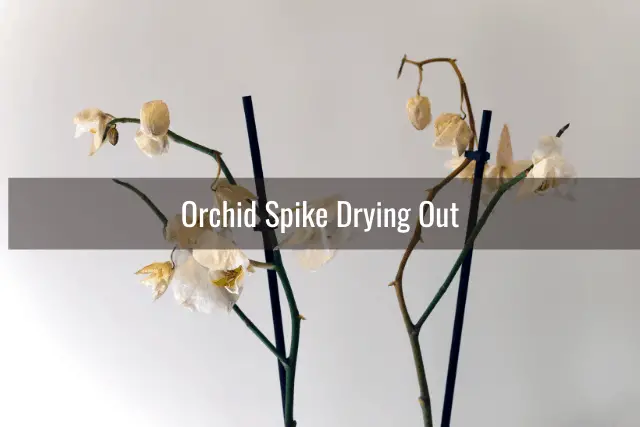
Orchid Spike Drying Out
If your orchid flower spike is drying out, it does not mean that your orchid is sick or dying. This is actually a normal process in most cases.
A dried brown or yellow flower spike is to be expected if the orchid has finished blooming. Essentially, the plant is done expending energy on growing blooms, and the flower spike has stopped transporting nutrients.
If the rest of the orchid is healthy, a dried out orchid spike is normal and not a cause for concern. Just to be sure though, check the leaves and roots for signs of pests or disease. This will help you make sure that the dying flower spike is not due to some nefarious cause. If all is well, then go ahead and prune off the dead spike using sterilized gardening shears.
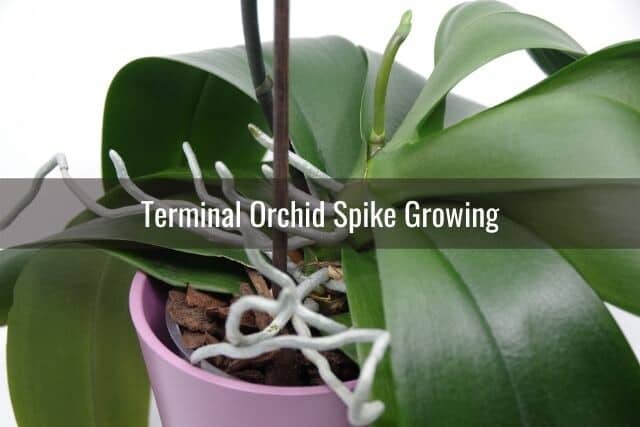
Terminal Orchid Spike Growing
A flower spike growing from the middle of the leaves of an orchid’s crown is referred to as a terminal spike. Unfortunately, in most cases, it signals that the orchid’s life is coming to an end.
However, do not throw your orchid out just yet! Your orchid still has some life in it.
Sometimes a dying orchid will produce a baby orchid, also known as a keiki. Regardless of whether it forms on the spike or at the base, be sure you leave it on the mother plant. Your orchid still has one or two years of life left.
I repeat, keep the orchid keiki attached to the orchid until it has several new roots and two good leaves. Once this has happened, you can safely separate it and plant it in a new pot.
Here are two more detailed guides for more information: how to care for keiki orchids, and how to propagate new orchids. Both of these guides will walk you through the step-by-step process of separating keiki orchids from the mother orchid. You’ll also learn how to nurture the baby orchids and support their growth afterwards. Be sure to check those guides out!
No one is quite sure why orchids develop terminal spikes. Theories range from improper maintenance to bad genes. Nor is there a guarantee your orchid will grow one or more keikis, so please don’t expect it to happen.
A keiki growing on a dying orchid is usually the orchid’s last ditch effort to pass on it’s genes, but not all dying orchids have the bandwidth to produce keikis.
Final Thoughts
Orchids have a reputation for being difficult to grow, which is why we watch them carefully for any sign of trouble. The good news is that problems with the orchid flower spike are not usually signs that the orchid is sick. Pat yourself on the back for asking the right questions—orchids are not difficult to care for if you know what to look for.
If you enjoyed this article, please pin it and share!
